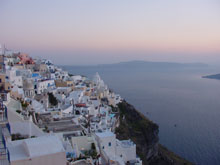Santorini
Best known for its deep blue waters, breathtaking sunsets and distinct red, black and white sand beaches, Santorini is an island of incredible wonder. However, Santorini has another story to be told. Beyond the aesthetic pleasure that the island’s terrain provides to thousands of tourists annually, there is a rich tradition of winemaking that dates back to ancient time.
The Island’s History
The first signs of winemaking in Santorini go all the way back to 3500 BC, but it was the catastrophic volcanic explosion near 1600BC that created the island’s unique terroir and has given the wines of Santorini the character they have carried throughout history. The basket trained “kouloura” vines of Assyrtiko, grown in the rocky volcanic soil throughout the island, produce a dry, full-bodied white wine with intense minerality and crisp acidity that make it a dream for pairing with a variety of cuisines.
During the first eruption, the center of the island collapsed thousands of feet into the sea, forming the famous Caldera of Santorini. This landmark created spectacular views throughout the island and is truly one of the natural wonders of the world. The destruction left the main island of Thira in a half-moon shape and also created a group of smaller islands that make up Santorini. They are Thirassia, Aspronisi and Old Kameni. Another island, New Kameni, was most recently formed from a violent earthquake in 1956.
After the great eruption, it took over 200 years before life could resume again on Santorini. Fortunately, some of the vines on the island were spared from the lava flow, located high atop the slopes of Mt. Profytis Elias. In ancient times the vines were often planted in terraces called “pezoules” on the sides of steep hills to protect them from the wind. Many of these pezoules, though abandoned long ago, still exist today, waiting for a time in the future when the vines will return to reclaim their destiny.
Looking Forward
Although Santorini is most popularly known for its highly sought after, dry, white PDO wines, made from Greece’s most noble white grape, Assyrtiko, the island also produces the original Vinsanto, or “Vini di Santorini” as it was called by the Venetians, and for which the island became famous in ancient time.
Today the popularity of Santorini as one of the world’s premier travel destinations has set it at odds with the island’s winemaking tradition, threatening the grape’s very survival. Because of the tough growing environment and the demanding viticultural practices required to maintain the vines, it has become a difficult economic choice for the producers to continue making wine. The average vineyard in Santorini is less than 1 hectare in size and is family owned, making it very hard for the growers to depend solely on the vine for their income.
Despite these challenges, the wine industry on Santorini still remains vibrant and is beginning to see a trend towards an increase planting of vines on the island.
Overall, Santorini represents a curious balance between ancient tradition and modern luxury while the wine culture that has existed there for millennia continues to improve with age.

















